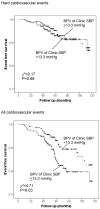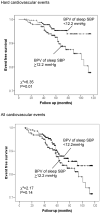Visit-to-visit and ambulatory blood pressure variability as predictors of incident cardiovascular events in patients with hypertension
- PMID: 22739805
- PMCID: PMC3839090
- DOI: 10.1038/ajh.2012.75
Visit-to-visit and ambulatory blood pressure variability as predictors of incident cardiovascular events in patients with hypertension
Abstract
Background: Visit-to-visit blood pressure variability (BPV) has been shown to be a prognostic indicator in hypertensive patients. We designed this study to clarify the impacts of clinic and ambulatory BPV in predicting cardiovascular disease (CVD).
Methods: We performed ambulatory BP monitoring (ABPM) in 457 hypertensive patients. Visit-to-visit BPV and ambulatory BPV were calculated as the SDs of clinic BP, awake BP, and sleep BP. The mean age of the subjects was 67.0 ± 9.2 years, and they were followed for 67 ± 26 months. Stroke, myocardial infarction, and sudden cardiac death were defined as Hard CVD events, and these plus angina, heart failure, and other CVDs were defined as All CVD events. Multivariable Cox hazard regression models predicting CVD events were used to estimate the adjusted hazard ratio (HR) and 95% confidence interval (CI) for different measures of BPV with adjustment for significant covariates.
Results: In multivariable analyses, the BPV of clinic systolic BP (SBP) was an independent predictor for All CVD events (HR, 2.20; 95% CI, 1.25-3.88; P < 0.01), but not for Hard CVD events (P = 0.20). On the other hand, the BPV of sleep SBP was an independent predictor for Hard CVD events (HR, 2.21; 95% CI, 1.08-4.53; P = 0.03), but not for All CVD events (P = 0.88). Diastolic BPV exhibited the same pattern.
Conclusions: These findings suggest that visit-to-visit BPV and ambulatory BPV are separately useful in predicting cardiovascular outcomes.
Figures


References
-
- Frattola A, Parati G, Cuspidi C, Albini F, Mancia G. Prognostic value of 24-hour blood pressure variability. J Hypertens. 1993;11:1133–1137. - PubMed
-
- Pringle E, Phillips C, Thijs L, Davidson C, Staessen JA, de Leeuw PW, Jaaskivi M, Nachev C, Parati G, O’Brien ET, Tuomilehto J, Webster J, Bulpitt CJ, Fagard RH, Syst-Eur investigators Systolic blood pressure variability as a risk factor for stroke and cardiovascular mortality in the elderly hypertensive population. J Hypertens. 2003;21:2251–2257. - PubMed
-
- Kikuya M, Hozawa A, Ohokubo T, Tsuji I, Michimata M, Matsubara M, Ota M, Nagai K, Araki T, Satoh H, Ito S, Hisamichi S, Imai Y. Prognostic significance of blood pressure and heart rate variabilities: the Ohasama study. Hypertension. 2000;36:901–906. - PubMed
-
- Tatasciore A, Renda G, Zimarino M, Soccio M, Bilo G, Parati G, Schillaci G, De Caterina R. Awake systolic blood pressure variability correlates with target-organ damage in hypertensive subjects. Hypertension. 2007;50:325–332. - PubMed
-
- Mancia G, Bombelli M, Facchetti R, Madotto F, Corrao G, Trevano FQ, Grassi G, Sega R. Long-Term Prognostic Value of Blood Pressure Variability in the General Population: Results of the Pressioni Arteriose Monitorate e Loro Associazioni Study. Hypertension. 2007;49:1265–1270. - PubMed
Publication types
MeSH terms
Grants and funding
LinkOut - more resources
Full Text Sources
Medical

